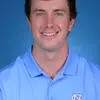University of North Carolina Athletics

GoHeels Exclusive: TrackMan Allows Carolina Golf To Practice Like The Pros
October 16, 2017 | Men's Golf, Women's Golf
By Pat James
If you've watched even one shot of a televised PGA Tour event in recent years, you've likely seen information like ball speed or ball-flight apex instantly appear on your television after each shot.
The technology that supplies such data can also be found in MLB. And it's available to members of the North Carolina men's and women's golf teams, thanks to the TrackMan launch monitors both teams regularly use in practices.
During the first-ever Tar Heel TrackMan Day earlier this season at the Williamson Golf Team Practice Facility, both teams showed attendees how TrackMan technology works by hitting balls on the driving range and explaining how they use the information provided.
"There are other devices that do similar things," said Andrew DiBitetto, who's in his first season as UNC's men's golf coach, "but not exactly quite like this does."
According to the TrackMan website, TrackMan employs Doppler radar technology, like what's used to track missiles, to capture the trajectory of your golf ball from launch to landing and also give you information about your clubhead. This data can range from simple stats like carry yardage and clubhead speed to smash factor and dynamic loft.
All of this data is measured by a monitor, about the size of a laptop, that is placed a few feet behind the golfer.

"Once you start understanding it, it's really helpful," said Jan Mann, who's in her ninth season as UNC's women's golf coach. "The golf swing happens in a split second. You can look at the ball flight and see what's going on, but it's also great to see, 'Alright, how open was the club face? What was the direction?'"
Another useful TrackMan tool is the normalization feature. This allows golfers who might be practicing in difficult weather conditions to see what the ball flight would have been under calm conditions. You can also adjust temperature and altitude to see how that affects distance and trajectory.
Sorting through the abundance of Trackman data can be challenging. Because of this, DiBitetto said it's important for the coaches to be aware of the golfer they're working with and which stats to monitor.
"I think it's all just about the relationship and knowing each individual on your team, knowing their personality," DiBitetto said. "Are they very analytical, or are they a more feel-type player? Then you kind of go off that.
"You know your guys, just like in any other sport. In basketball, if somebody needs to work on their transition defense or whatever the case may be. We know that with our guys, and you kind of go based off that. You just make sure there's a clear purpose to it."
The information TrackMan provides is easily accessible. Each shot is logged on mytrackman.com, which can be adapted to your preferred device (smartphone, laptop or tablet) so you can check your TrackMan numbers wherever you are. Multiple tablets and smartphones were passed around Monday so attendees could see the TrackMan numbers for each shot.
However, Mann said she's careful with her golfers and how much they access the numbers so they don't overload with technical information.
"It's OK for them to have an understanding of the mechanical piece of it," she said. "But where we think it's the most helpful for everybody in general is to understand what their yardages are, what their carry yardages are, and then to be able to dial in those numbers."
Players showed how in tune they are with those numbers Monday. During one demonstration, a few golfers alternated taking five pitch shots apiece, attempting to land the ball near targets 50, 70, 90, 110 and 130 yards out. No shot strayed too far.
The TrackMan numbers have also helped during competition.
Assistant men's golf coach Matt Clark compiled a list of each golfer's carry numbers for the Olympia Fields/Fighting Illini Invitational from Sept. 15-17. And on one par-3 hole, DiBitetto said those numbers came in handy for junior Preyer Fountain.
"It was literally the perfect number for a 7-iron," DiBitetto said. "And we got to say, 'No, no, no, this is absolutely golden. This is going to be perfect.' And (he) hit it within six inches. It's helpful in situations like that where it gives us some real numbers and some facts."





